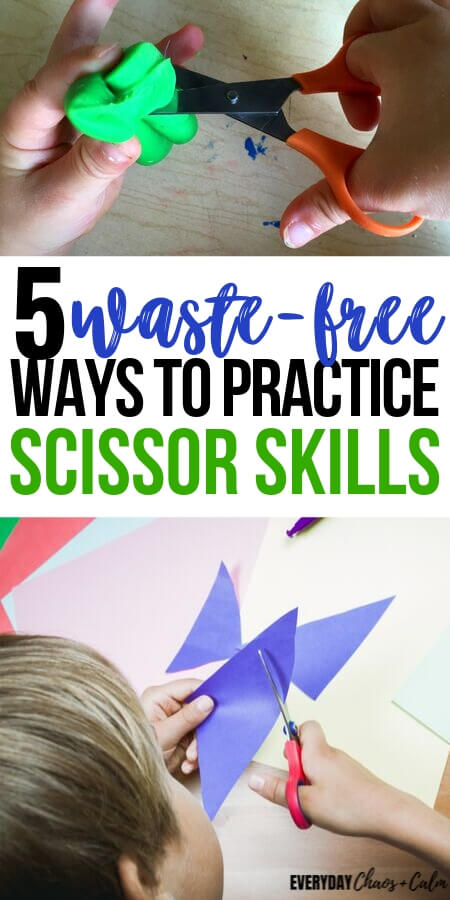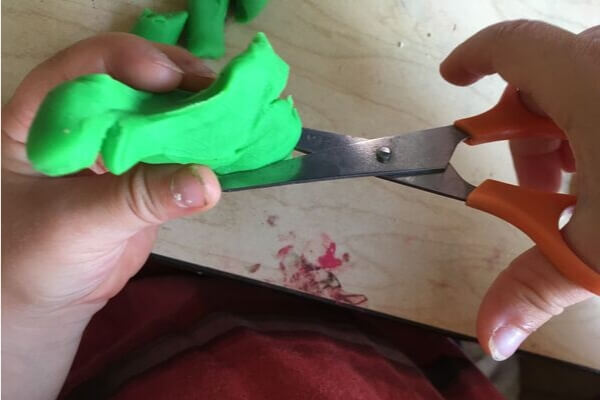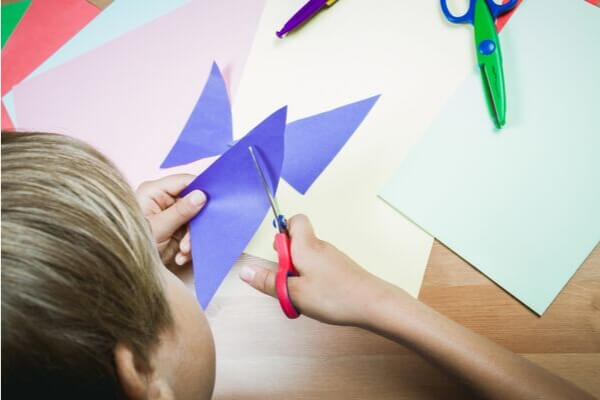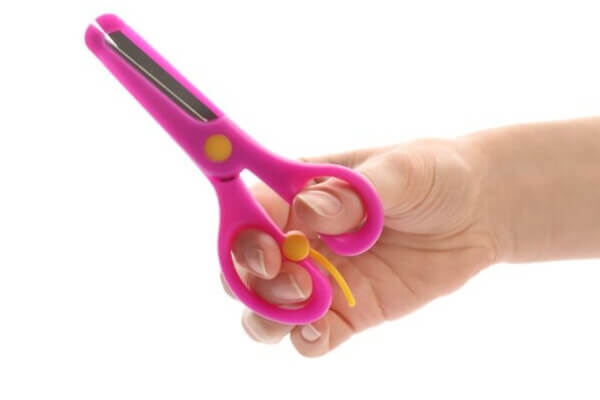Does your child need some cutting practice or help building his scissor skills but you don’t want to waste a bunch of paper while he does it? Here are 5 ways to give the all needed scissor cutting practice without the waste!
I guess I should count myself lucky that, after raising 6 toddlers, I have yet to have a child take scissors to their own hair. But kids are drawn to scissors, right? They are this tool that is in their reach, but not quite.
** This website contains affiliate links. If you make a purchase using one of these links, I may earn a commission. Please click here for more information about cookies collected and our privacy policy **.
And scissor skills are actually a very important skill for kids. And cutting on a line is definitely a struggle sometimes.
We all know that cutting practice is important for kids, but it’s something we sometimes put off. And I know from my own personal experience that kids get pretty frustrated with it- cutting takes a lot of practice after all. So it’s just easier to take over when your child hands you something to cut out for them.
So how do you give your child less frustrating cutting practice? You start small and no stress. No lines. No rules. Just cutting. Then you slowly work up as they build their scissor skills.

How to Give Your Child Scissor Cutting Practice– Without Wasting Paper
You can find a gazillion free cutting practice printables online. Lines on a paper ready for them to cut.
My biggest problem with these cutting practice sheets…it’s wasteful!
Paper can be expensive. It’s not environmentally friendly to just cut it up without a purpose. So below are 5 ways you can give your child cutting practice with scissors that don’t waste.
Cutting Practice with Playdough
Playdough is the best way for very young kids to practice cutting. It gives them a soft and reusable surface to practice holding their scissors and making small cuts. And since it cuts so easily it’s virtually frustration-free. Here are some tips for cutting practice with playdough (or clay):
- Roll the dough into short snakes that your child can hold in one hand and snip in the other.
- Make thick “cookies” for them to snip
- The dull kid-safe scissors are best
- If you are working with a small child make sure to arrange the hand correctly
Here’s my favorite homemade playdough recipe to try using scissors with!

Cutting Grass or Leaves
This is a favorite of my toddler! Cutting grass or leaves is a really fun no-waste way to get some cutting practice!
Grass is best for really young kids who just need to practice the skill of opening and closing the scissors. They don’t have to hold the grass since the ground does the job for them. And since grass is so thin and small you don’t have to open the scissors very wide at all.
Leaves are another great option. Brown, crunchy leaves in the fall will cut very easily. While green leaves will be more like paper.
So get outside for your next cutting practice session! Just be sure your child knows the proper way to hold and walk with scissors.
Cut Recyclables
At some point cutting paper becomes necessary. After all, that is what we cut 90% of the time, right?
But when your child is still just learning to hold scissors properly, how to move in a straight line, or follow a curve without a lot of purpose, recycling is the way to go.
My favorite recyclable is junk mail. Junk mail is perfect for toddler or preschooler cutting practice! They can snip it any way they want- and you can throw it away without guilt!
You can also draw lines for them to follow using a dark marker for more advanced scissor practice.

Make a Collage
Once your child has moved past simple snips and they start to feel more confident with their scissor skills you may find that they argue when you try to toss their hard work in the trash.
My son even argues when I try to throw out his pile of junk mail pieces that he worked so hard to create.
At this point, get out the glue and let them make a collage! Turn that cutting practice into a piece of art!
Cut and Craft
Take the collage a step further and start to do crafts that specifically NEED scissors.
Do crafts that require your child to cut out shapes or strips of paper. They can work on advanced scissor skills like cutting long lines, alone a curved line, or a free form shape but still have a purpose.
They can use their cuttings to create bigger and better crafts that they can feel proud to display or give away as gifts.
Examples of this would be:
- Cut long strips of construction paper and weave them into a place mat
- Cut specific shapes to then glue together into things like vehicles, houses, animals, etc.
- Cut squares to make a mosaic design
Why Cutting Practice is Important
Why should you make a point to give your child cutting practice?
It builds the muscles in the hand. These small muscles are important to strengthen and are uses in things like writing and gripping. Here are more fine motor activities to do with your young child to build these muscles.
Cutting practice helps build hand-eye coordination. (Hammering is another activity that builds hand-eye coordination. Try hammering cereal for more practice!)
Cutting encourages bilateral coordination. That is using 2 hands to do two separate tasks- IE. holding the paper in one hand, while cutting in the other.

The Best Scissors for Cutting Practice
My favorite first scissors for learning to cut are the ones that have a spring action that helps reopen the scissors after closing. These scissors really help reduce frustration when kids are learning to open and close the scissors AND cut at the same time.
==> Learn more about the Spring-Action Kids Scissors
Once they are proficient at cutting with the spring action scissors, move on to regular kids scissors. I recommend getting good quality scissors for cutting practice.
We often think that dull equals safe, when that isn’t always the best way of thinking. You should look for blunt tip scissors with a sharp blade.
Nothing is more frustrating than the paper jamming or bending when trying to cut!


